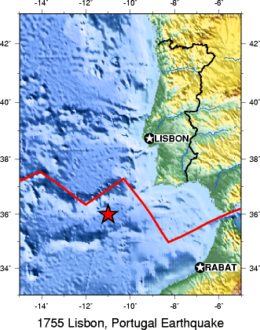Lisbon earthquake
 |
|
| Date | 1 November 1755 |
|---|---|
| Magnitude | 8.5–9.0 Mw (est.) |
| Epicenter |
36°N 11°W / 36°N 11°WCoordinates: 36°N 11°W / 36°N 11°W About 200 km (120 mi) west-southwest of Cape St. Vincent |
| Areas affected | Kingdom of Portugal, Kingdom of Spain, Kingdom of Morocco. The tsunami affected Southern Great Britain and Ireland |
| Max. intensity | XI (Extreme) |
| Casualties | 10,000–100,000 deaths |
The 1755 Lisbon earthquake, also known as the Great Lisbon earthquake, occurred in the Kingdom of Portugal on Saturday, 1 November, the holy day of All Saints' Day, at around 09:40 local time. In combination with subsequent fires and a tsunami, the earthquake almost totally destroyed Lisbon and adjoining areas. Seismologists today estimate the Lisbon earthquake had a magnitude in the range 8.5–9.0 on the moment magnitude scale, with its epicentre in the Atlantic Ocean about 200 km (120 mi) west-southwest of Cape St. Vincent. Estimates place the death toll in Lisbon alone between 10,000 and 100,000 people, making it one of the deadliest earthquakes in history.
The earthquake accentuated political tensions in the Kingdom of Portugal and profoundly disrupted the country's colonial ambitions. The event was widely discussed and dwelt upon by European Enlightenment philosophers, and inspired major developments in theodicy. As the first earthquake studied scientifically for its effects over a large area, it led to the birth of modern seismology and earthquake engineering.
In 1755, the earthquake struck on the morning of 1 November, the holy day of All Saints' Day. Contemporary reports state that the earthquake lasted between three and a half and six minutes, causing fissures 5 metres (16 feet) wide to open in the city centre. Survivors rushed to the open space of the docks for safety and watched as the water receded, revealing a sea floor littered with lost cargo and shipwrecks. Approximately 40 minutes after the earthquake, a tsunami engulfed the harbour and downtown area, rushing up the Tagus river, "so fast that several people riding on horseback ... were forced to gallop as fast as possible to the upper grounds for fear of being carried away." It was followed by two more waves. In the areas unaffected by the tsunami, fire quickly broke out, and flames raged for five days.
...
Wikipedia
